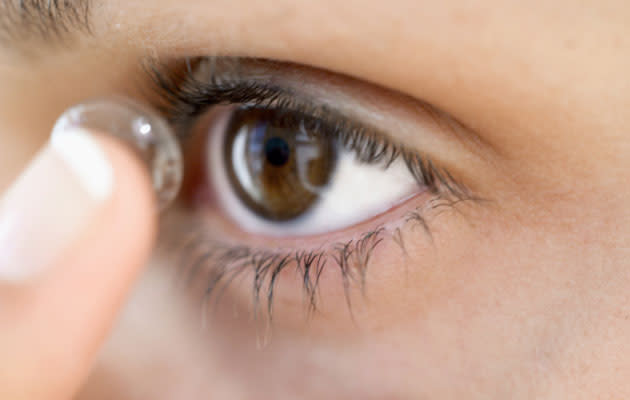 Fit to Post Health
Fit to Post HealthHow poor contact lens hygiene can harm your eyes

It may be convenient to wear contact lenses to sleep or swim but it can put you at risk for developing corneal ulcers, corneal abrasions and eye infections. With proper treatment, most people will recover. But for serious corneal damage and infection, you may need a corneal transplant to restore vision.
The cornea is the clear, protective layer covering the front of the eye. Wearing dirty contact lenses can cause the cornea to be infected and inflamed with corneal ulcers that are infected erosions in the cornea. Poorly-fitted contact lenses can also scratch the cornea. These corneal ulcers often result in severe eye pain and blurred vision.
"Many young working adults prefer the convenience of wearing contact lenses to glasses. To maintain healthy eyes, practise good contact lens hygiene and keep wear time down to less than eight hours a day," says Adjunct Associate Professor Jod Mehta, head and consultant (Research), Corneal and External Eye Disease Service at the Singapore National Eye Centre (SNEC).
When a corneal ulcer results in thinning, clouding or perforation of the cornea, a corneal transplant is required to restore vision — and save the eye, adds Adjunct A/Professor Mehta.
Related video: Can eye makeup harm your eyes?
Vision loss from corneal damage
There are several causes of visual loss due to corneal disease. A progressively thin cornea can lead to a disorder called keratoconus, where vision becomes distorted when the normally round-shaped cornea changes into a cone shape. Infections and injuries can cause the cornea to become increasingly cloudy and opaque, so light rays cannot reach the retina, resulting in poor vision or corneal blindness.
Other causes for corneal damage
Besides contact lens misuse, corneal damage can result from:
Trauma caused by external eye injuries
Degeneration of the innermost layer of the cornea called endothelium, due to ageing
Eye diseases such as keratoconus and herpes simplex virus
What is a corneal transplant?
A corneal transplant is a procedure in which the damaged or diseased cornea is removed and replaced with a new donor cornea.
In traditional corneal transplant (penetrating keratoplasty), the surgeon cuts through the entire thickness of the damaged or diseased cornea and removes a recipient button of approximately 8 mm in size. The round donor cornea is then placed on the recipient and secured with fine sutures
Related video: What eye symptoms should prompt you to seek urgent medical attention?
Lamellar keratoplasty
In newer corneal transplant techniques such as Anterior Lamellar Keratoplasty (ALK), only the superficial, damaged or diseased front layers of the cornea are removed, thus preserving the corneal endothelium, the deep, innermost layer of the cornea.
Deep Anterior Lamellar Keratoplasty (DALK) is similar to ALK except that it removes nearly all of the front layers of the cornea down to almost the deepest layer - Descemet's membrane.
Surgeons usually perform these corneal transplant procedures for misshapen corneas (keratoconus) and corneal scars. About 30 per cent of SNEC's corneal transplants are ALK and DALK procedures.
Endothelial keratoplasty: A new form of sutureless corneal transplant
In advanced corneal transplant procedures such as DMEK (Descemet's Membrane Endothelial Keratoplasty) and DSAEK (Descemet's Stripping Automated Endothelial Keratoplasty), only the diseased innermost endothelial layer is replaced, leaving most of the original cornea intact.
"Endothelial keratoplasty is probably the most significant advance in corneal transplantation today, because it is essentially a new form of sutureless, keyhole corneal transplantation", says Adjunct A/Prof Mehta.
As it requires only a small incision at the side of the cornea and no sutures on the surface of the cornea, the eye is much stronger, visual recovery is faster and there is less refractive unpredictability.
Related article: More info on DMEK, a new and improved corneal transplant procedure
More than 40 per cent of corneal transplants at SNEC are endothelial keratoplasty.
"Although complications can happen as with any surgical procedure, advanced surgical techniques e.g. with our Endoglide (developed at SNEC) have reduced these and made corneal transplantation a relatively safe surgery with shorter recovery time and lower risk of rejection," says Adjunct A/Prof Mehta.
Have questions related to corneal transplant? Health Xchange offers you the chance to get doctor's answers for FREE in its "Ask the Specialist" online Q&A session this month (September 2012). BONUS: The first 20 people to post a valid question will receive a free thumb-drive! Visit HealthXchange.com.sg, Singapore's trusted health and lifestyle portal.
This article was written by Teresa Cheong for Health Xchange, with expert input from the Corneal and External Eye Disease Service at the Singapore National Eye Centre (SNEC).
Find more health-related tips and articles on HealthXchange.com.sg, Singapore's trusted health and lifestyle portal.
Health Xchange's articles are meant for informational purposes only and cannot replace professional surgical, medical or health advice, examination, diagnosis, or treatment.

